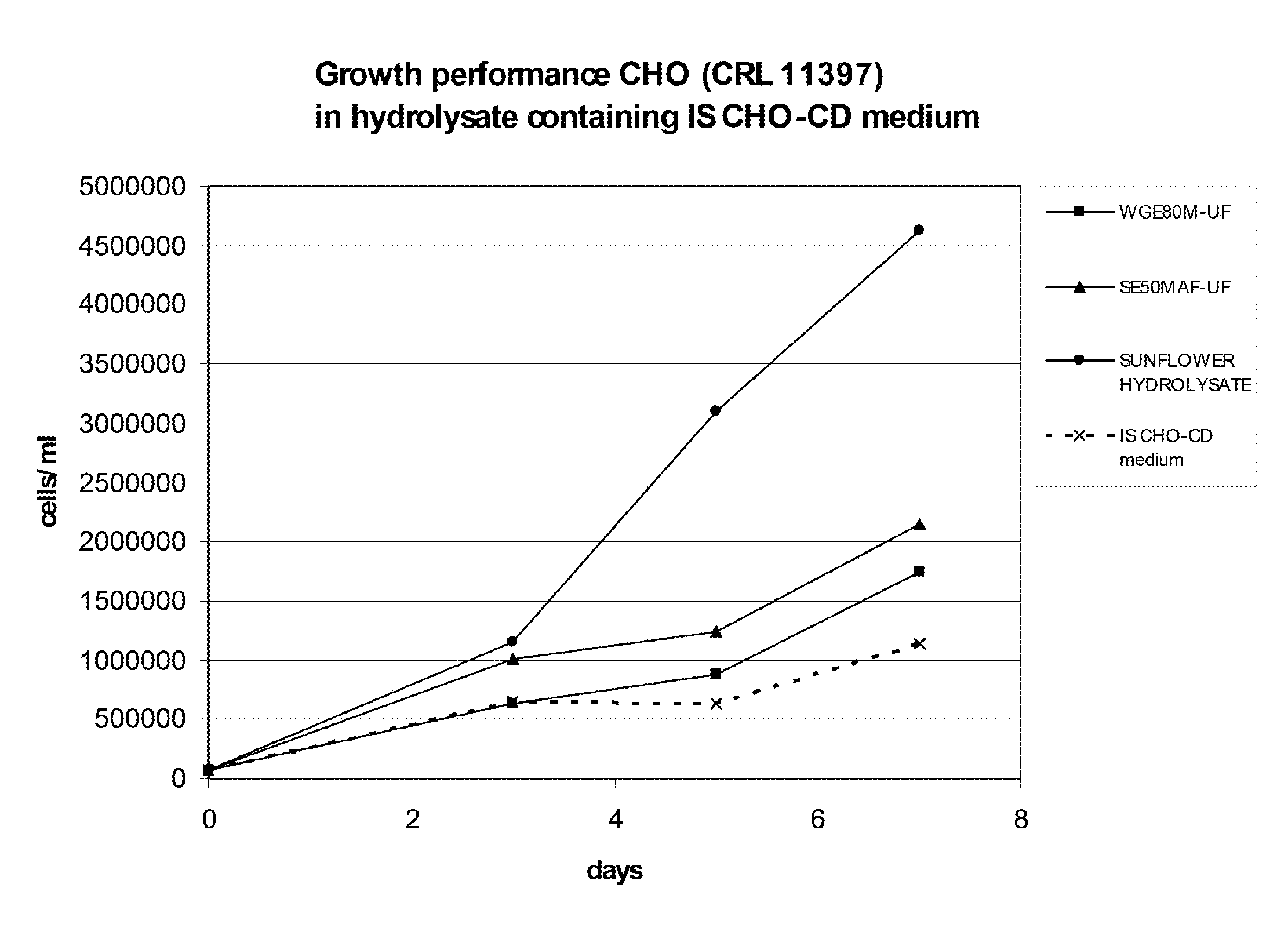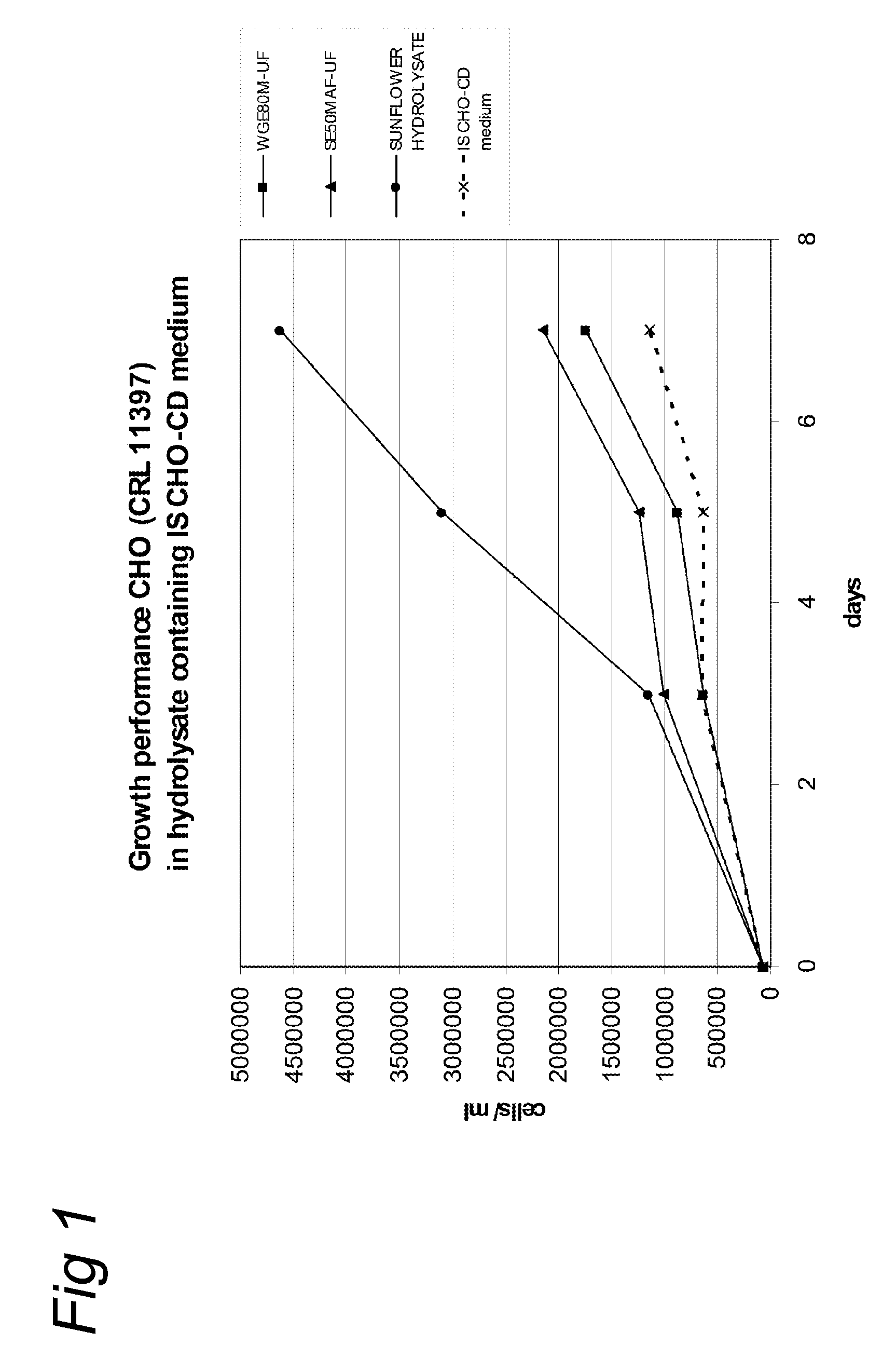Culture medium for eukaryotic cells
a technology for eukaryotic cells and culture medium, which is applied in the direction of fermentation, biochemistry apparatus and processes, culture process, etc., can solve the problems of contaminating the cultures and biopharmaceutical products, all serum-derived products can be contaminated by unknown agents, and the risk of bse contamination of bovine derived protein products like hydrolysed milk proteins or bovine meat or collagen hydrolysates, etc., to achieve bright and transparent appearance, excellent suitability for culturing
- Summary
- Abstract
- Description
- Claims
- Application Information
AI Technical Summary
Benefits of technology
Problems solved by technology
Method used
Image
Examples
example 1a
Preparation of Sunflower Protein Seed Hydrolysate
[0032]200 g defatted sunflower meal from ADM (35% wt protein) was dispersed in 1.8 kg water at 60° C. to make a 10% solution. The pH of the solution was adjusted to 7.5±0.1 with 50% sodium hydroxide. To this solution, 5.05 g (2.5% on solids) of Alcalase 2.4 L (NOVOZYMES, USA) was added. The pH was allowed to drift during the hydrolysis. After 4 hours of hydrolysis at 60° C., the pH of the solution was adjusted to 6.7±0.1 with 50% sodium hydroxide and the solution was batch inactivated at 95° C. for 30 min. The solution was cooled to 60° C. and approximately 100 g of Hyflo diatomaceous earth (DE) was added and the solution was filtered using a Buchi vacuum filtration funnel and filter paper. After filtration the solution was freeze dried. This hydrolysate is named S1.
Analysis of S1
[0033]Table 1 shows the molecular weight distribution as analysed with a Superdex peptide column (Amersham Biosciences). The column was calibrated with prote...
example 1b
[0035]A solution of 10% solids was made with high protein sunflower meal (High Protein Sunflower Pellets, 37% total protein, of Glencore International), at 60° C. in a water bath. The slurry was heat treated at 80° C. for 10 minutes. Then it was cooled to 60° C. and the pH was measured. Sodium hydroxide was used to adjust the pH to 7.5±0.1. Alcalase enzyme was added to the mixture at 4% concentration on solids base and hydrolysis was carried out for 6 hours at 60° C. After 6 hours, the slurry was heat inactivated at 95° C. for 30 minutes. The hydrolysed mixture was vacuum-filtered to remove the coarse impurities. The slurry was then ultra-filtered using a Koch HFK-131 spiral wound membrane device having a cut-off of 10,000 Da, and spray dried to obtain a powdered hydrolysate. The degree of hydrolysis obtained in this example was 36%. This hydrolysate is denoted as S2.
example 1c
[0036]A procedure similar to Example 1b was performed except that the enzyme papain from Merck was used at 2% concentration on solids base. The mixture was hydrolysed for 3 hours and then heat inactivated at 95° C. for 30 minutes. The degree of hydrolysis obtained in this example was 25%. This hydrolysate is denoted as S3.
PUM
| Property | Measurement | Unit |
|---|---|---|
| reaction time | aaaaa | aaaaa |
| weight ratio | aaaaa | aaaaa |
| weight ratio | aaaaa | aaaaa |
Abstract
Description
Claims
Application Information
 Login to View More
Login to View More - R&D
- Intellectual Property
- Life Sciences
- Materials
- Tech Scout
- Unparalleled Data Quality
- Higher Quality Content
- 60% Fewer Hallucinations
Browse by: Latest US Patents, China's latest patents, Technical Efficacy Thesaurus, Application Domain, Technology Topic, Popular Technical Reports.
© 2025 PatSnap. All rights reserved.Legal|Privacy policy|Modern Slavery Act Transparency Statement|Sitemap|About US| Contact US: help@patsnap.com



